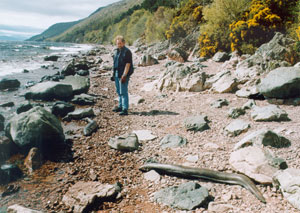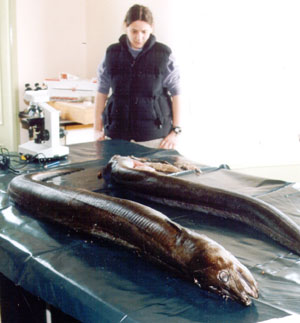The Loch Ness Project 
Loch Ness
Centre
Operation Cleansweep 2001
|
|||
 |
Tony Harmsworth reported this to Adrian Shine at Loch Ness 2000, who visited the site and had them transported to the Loch Ness Project's laboratory within the Centre.
He identified them as conger eels (Conger conger) which are exclusively marine. This identification was confirmed by Tony Wall of the Inverness based Fish Vet Group. A post mortem also revealed that one of them had been feeding on Mackerel, another salt water fish. Both had been killed by punctures to the brain and there were signs of gaff marks. The larger eel was 6ft 1.25 ins long (1.86m) with a circumference of 22 ins (.55m) and weighed 20.8kg.
 |
Clearly, the eels had arrived by human agency in two possible ways. They could have been thrown overboard from a passing fishing vessel. A number of trawlers had passed through the Caledonian Canal on the previous day. However, congers are seldom caught in trawls since they tend to hide in rocky ground or in wrecks. Also, one of the eels was found clear of the surf. A more likely explanation is that they had been placed by a sea angler, inspired perhaps by the publicity surrounding Mr. Sundberg's ideas about large eels. The location, directly beneath a busy lay-by suggests this.
The incident is reminiscent of the skinned dolphin reported by the Inverness Courier to have been cast overboard by "the waggish crew" of a passing fishing vessel in October 1868 to fool "the credulous natives of Abriachan". Perhaps today, the natives of Abriachan are less credulous!